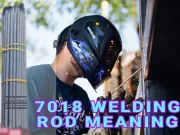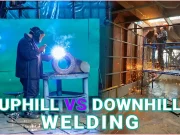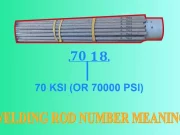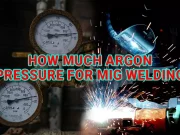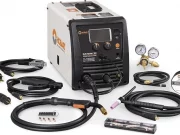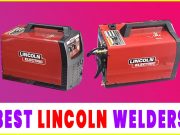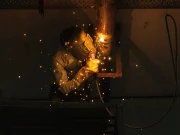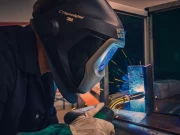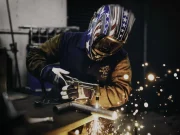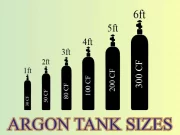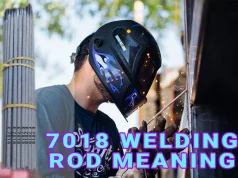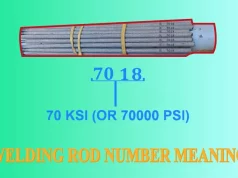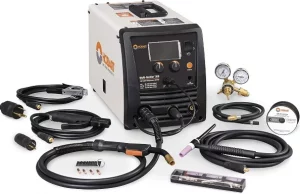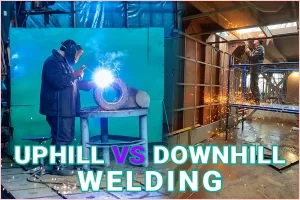
Welding is a crucial part of our lives, and we need people with such skills to help us with connections.
You use welding in piping, construction, and many other projects, so it can be a skill worth picking up if you want to get handy.
There are numerous types of rods you could use for welding, and they are of different sizes and have different uses.
This difference leads to two standard techniques of welding, uphill and downhill. Let us get into the details and see the differences if there are any;
Uphill Vs. Downhill Welding
When welding in a vertical position, you have to choose between uphill and downhill welding, and this can be a complicated matter since the wrong choice can cause damage.
Let us look at these two and see what differences they have to know which one is the better choice.
Both types of welds are important, and they will hold up well if you use them in the correct situations.
- One of the biggest differences in using these two welding methods is their structural strength once they are complete.
This is one of the most significant factors when determining which welding method you should use.
Uphill welds are significantly more secure than downhill welds since they have thicker joints holding the metal together; thus, they can handle much pressure.
On the other hand, downhill welds are not good for stress since they are thinner and can’t handle much of it.
Therefore, you can use uphill welding for locations with a lot of traffic or support more weight since it can take it. Downhill welding is often the option to fix a crack or space that doesn’t need strong support.
- Another major difference between uphill and downhill welding is the type of metal you can use with them. Downhill welds have less penetration, while uphill welds will demand more penetration for them to hold.
This is important when choosing the method you use for welding. Uphill welding will work best for rough, thick pieces of metal like refinery pipes. These have enough thickness for the uphill welding to penetrate and hold.
On the other hand, Downhill welds don’t need too much penetration to hold; thus, they can work with a thinner metal piece. If you try uphill welding on a thin surface, there is a chance you will burn through it and mess it up. Downhill welding will be the best choice for such joints.
- The speed of working is another difference you will notice when working with these welding methods.
Uphill welding takes much longer than downhill since it needs more time to penetrate the metal enough to hold the joint.
Uphill welds also require more angles and rod skills to ensure you get a uniform, well-sealed joint. Downhill welds are much quicker since they don’t burn too much into the metal when you weld.
As such, you can use it for quick fixes for cracks, airtight seals, or other areas without too much pressure. They are faster and more effective when used in the right places; otherwise, you will lose structural integrity.
- The technique involved in these tasks is another difference you could use in their classification. Uphill welding is a powerful and effective method, but its technique is the hardest to learn.
You need to know how to weld shelves at the bottom, use triangular weaves for the first run, then reinforce it with another layer as you move up. There are more complex techniques, and they all need a lot of skill to execute.
Downhill welds are generally easier, and most beginners can handle them. People use different techniques for downhill welds, and it is relatively easier to get your footing here.
To sum everything up, if you had to choose a type of weld to use, it would be better to weld uphill rather than downhill.
Uphill welds are stronger because of the additional penetration, making them a bad choice for thin plates as they can easily cut through them.
Types Of Welding
Most people that want to get into welding don’t think about how complicated it is since it seems basic from an outside glace.
However, you need to understand the welding systems and the best situations to use each one of them; let us get into the details;
If you are thinking about welding as a career, you have to learn more about it. There are 3 basic elements in welding: a heat source, the flux or shielding gas, and filler metal.
1. MIG Welding
For this, your electrode is the filler metal on a spool of wire with a shielding gas process. The advantage of this is that it is easier to master since you will preset all the settings, managing most of the precision work.
It will also lead to a cleaner weld since you won’t have any slag, and you can manage a uniform, smooth weld with little effort.
You can also use it on a wide range of metal thicknesses, provided you understand how to choose the right rod for the job.
2. Stick Welding
This is a flux welding process; thus, it works well outside since wind and other outdoor conditions don’t affect it as much.
You need to ensure you have the best Stick welding rod to give you the best penetration and stronger joints.
Stick welding will also work well for thicker metals; thus, it can be a great choice for professional heavy-duty jobs.
Another advantage of this system is that rust and dirt don’t affect it like other processes; thus, you can use them on dirty surfaces.
One of the biggest issues with stick welding is that you will have a lot of spatter and fumes; thus, you need a good welding helmet and gloves to protect your face and hands from sparks. You will also have issues getting a clean weld, and you might have to grind it.
3. TIG Welding
This is the most accurate and highest quality welding option you can go with, and it will give you a nice smooth finish.
It also works great on thinner metals, but it has a problem since you have to control all three elements while welding.
Your foot controls the heat, one hand controls the deposition metal, and you also need to move the electrode.
TIG welding also produces a bright flash as it burns the metal, and it could be harmful if you look into it directly, so you need to find the right welding mask to protect your eyes and face. It looks good but takes more time to master and weld than other systems.
Welding Basics For Beginners
Welding is a complex topic, and you need proper guidance to help you get the right skills to make better welds.
You can use welding as a full-time career and make a decent living from it if you have enough skills.
You can also take up welding with the intention of doing some DIY maintenance or projects at home.
Regardless of your reasons, you need to understand some basics of your skill acquisition process to help you gain the most from it.
It depends on what you plan to do most; if you are outdoors welding farm equipment that probably has rust, you will go with a stick welder. Working on thin metals or frames, you should learn about TIG welding processes.
MIG welding will be the best for you if you intend to work indoors for the most part. The welding processes work differently with metals, and you have to account for it. MIG will weld steel, stainless steel, and aluminum alloys.
Stick welding works best with cast iron, stainless steel, and steel, but it won’t work for other metals.
TIG is the most diverse choice; it can weld any metal that conducts electricity; steel, aluminum, stainless steel, brass, copper, magnesium, and titanium.
You will have to learn specifically based on what you need, but you can start with TIG to be safe since it works with most metals.
As you progress, you can pick up more skills and have a better time welding your joints into place.
Welding is a hazardous activity, and you need to take the necessary steps to ensure you don’t hurt yourself while welding.
You can visit weldingmagazine.com to get the best guides on buying safety gear and using welding equipment to ensure your safety.
Conclusion
Uphill and downhill welds are a choice that will come up when you need to weld vertically, and it’s a common choice for welding pipes. The two are effective in the right situations, but they can be counterproductive if you use them incorrectly.
Uphill welds penetrate deeper into the metal, and you might create holes in thinner metals; downhill welds don’t have as much penetration, so you will not get as much strength from it. Eventually, you need to have the right skills to know which method will work best for you.
You May Like These Articles As Well:
Can You Weld Stainless Steel To Mild Steel?
Best Tig Welding Gloves- A Guide To Choosing Right Welding Gloves


